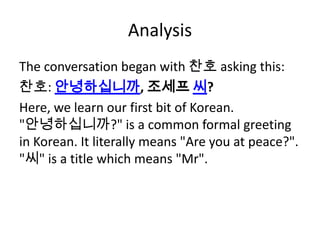Analysis
•Download as PPTX, PDF•
0 likes•2,005 views
The document analyzes a conversation between Chanho and Joseph in Korean. It provides translations and explanations of common Korean greetings like "Annyeonghashimnikka" meaning "Are you at peace?" and responses like "Ye" meaning "Yes". It also analyzes the basic structure of a Korean sentence using the example "Jeoneun jibe gabnida" meaning "I go home" and explains the roles of subjects, topics, locations and verb conjugations.
Report
Share
Report
Share

Recommended
More Related Content
What's hot
What's hot (20)
Viewers also liked
Viewers also liked (6)
Similar to Analysis
Similar to Analysis (20)
Recently uploaded
Mehran University Newsletter is a Quarterly Publication from Public Relations OfficeMehran University Newsletter Vol-X, Issue-I, 2024

Mehran University Newsletter Vol-X, Issue-I, 2024Mehran University of Engineering & Technology, Jamshoro
Recently uploaded (20)
HMCS Vancouver Pre-Deployment Brief - May 2024 (Web Version).pptx

HMCS Vancouver Pre-Deployment Brief - May 2024 (Web Version).pptx
Python Notes for mca i year students osmania university.docx

Python Notes for mca i year students osmania university.docx
ICT role in 21st century education and it's challenges.

ICT role in 21st century education and it's challenges.
ICT Role in 21st Century Education & its Challenges.pptx

ICT Role in 21st Century Education & its Challenges.pptx
Food safety_Challenges food safety laboratories_.pdf

Food safety_Challenges food safety laboratories_.pdf
Interdisciplinary_Insights_Data_Collection_Methods.pptx

Interdisciplinary_Insights_Data_Collection_Methods.pptx
Basic Civil Engineering first year Notes- Chapter 4 Building.pptx

Basic Civil Engineering first year Notes- Chapter 4 Building.pptx
This PowerPoint helps students to consider the concept of infinity.

This PowerPoint helps students to consider the concept of infinity.
Salient Features of India constitution especially power and functions

Salient Features of India constitution especially power and functions
HMCS Max Bernays Pre-Deployment Brief (May 2024).pptx

HMCS Max Bernays Pre-Deployment Brief (May 2024).pptx
Analysis
- 1. Analysis The conversation began with 찬호 asking this: 찬호: 안녕하십니까, 조세프 씨? Here, we learn our first bit of Korean. "안녕하십니까?" is a common formal greeting in Korean. It literally means "Are you at peace?". "씨" is a title which means "Mr".
- 2. 조세프: 예. 안녕하십니까, 찬호 씨? "예" means "yes". Typically, the response to "안녕하십니까?" is "예", but it is not necessary to respond that way. 찬호: 만나서 반갑습니다. "만나서 반갑습니다" means "Nice to meet you." This can also be shortened to "반갑습니다„ "만나서" means "because we've met".
- 3. 조세프: 저도요. 저는 집에 갑니다. Here, we learn some important things about making a Korean sentence. "저" means "I," and "저도요" means "Me too". Then Joseph says: "저는 집에 갑니다." This means "I go home." 찬호: 예.안녕히 가십시오. 조세프: 안녕히 계십시오. Both say goodbye to each other, but in Korean you differentiate between who is staying and who is leaving.
- 4. Sentence Analysis: 저 는 집 에 갑니다 I (topic) house (location) go As mentioned above, 저 means "I". In Korean, "는" marks the primary topic of a sentence. Joseph is talking primarily about himself, so he says "저는". So, if Joseph wanted to talk primarily about his house (집) instead of himself, he would say "집은".
- 5. "에" is in a similar class of elements (called "particles"), but it marks the location, such as "to school (학교에), to the bathroom (화장실에)," and so forth. Finally, we see the verb, "갑니다." Now, if you were to look up "go" in a Korean dictionary, it would probably say "가다." This is the verb's unconjugated dictionary or "base" form. "가" is the actual root of the verb. The standard, polite statement conjugation in Korean is {rooz + ㅂ/습니다}
